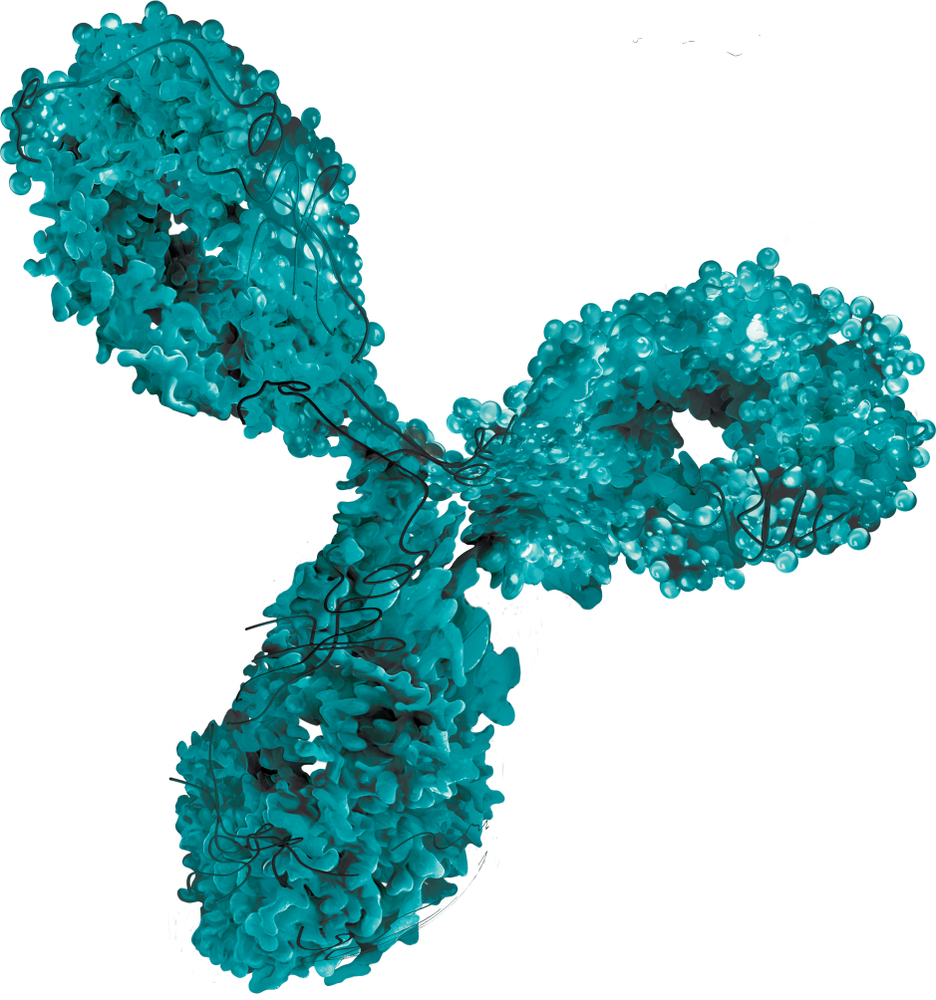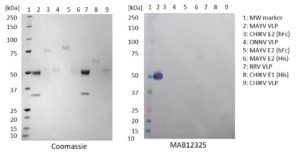Western blot: Antibody is specific for Mayaro virus-like particles (Lane 2; MAYV VLP) containing E1 protein. MAYV VLP contains capsid protein (~29kDa), Spike glycoprotein E2 (~47kDa) and Spike glycoprotein E1 (~48kDa). It did not cross-react with MAYV E2 (Lane 5; human Fc-tag, Lane 6; His-tag), Chikungunya virus VLP (Lane 9; CHIKV VLP), CHIKV E2 (Lane 3; human Fc-tag) or CHIKV E1 (Lane 8; His-tag), O’nyong nyong virus VLP (Lane 4; ONNV VLP) and Ross River virus VLP (Lane 7; RRV VLP).
Mouse Anti-Mayaro Virus E1 (M951)
Price range: $454.04 through $1,139.31 excl. VAT
Mouse anti Mayaro virus E1 (M951) protein antibody specific for MAYV. Matched pairs available and suitable for use in sandwich ELISA.
MOUSE ANTI-MAYARO VIRUS E1 (M951)
This mouse anti Mayaro virus E1 (M951) protein antibody is specific for MAYV. Suggested pairs include MAB12326 for capture paired with MAB12324 for detection. We also suggest MAB12324 for capture paired with MAB12325, MAB12326 or MAB12327 for detection.
PRODUCT DETAILS – MOUSE ANTI-MAYARO VIRUS E1 (M951)
- Mouse anti Mayaro virus E1 (IgG2a, clone M951) is specific for Mayaro virus E1. Antibody does not recognise MAYV VLP (REC31616) in antigen-down ELISA, but does detect VLP containing E1 by Western blot.
- Immunogen used was recombinant Mayaro Virus E1 antigen, Strain Acre27.
- Purified by Ion Exchange. >90% purity by SDS-PAGE.
- Presented in phosphate buffered saline, pH 7.2 with 0.05% sodium azide.
BACKGROUND
The Mayaro virus capsid is composed of 240 capsid protein copies within a lipid membrane, through which 80 capsid spike proteins penetrate. Each spike protein is composed of E1-E2 heterodimeric trimers. E2 is thought to be responsible for binding cellular receptors to mediate entry, whereas E1 is involved primarily in cell fusion (Smith et al., 2018). After a MAYV attaches to a target cell and is endocytosed, the lower pH of the cellular endosome induces dissociation of the E1-E2 heterodimers to allow trimerization of E1 subunits. These E1 trimers then promote the release of the virion from the endosome and into the cytoplasm for viral replication.
The Mayaro virus (MAYV) is a positive-sense, single-stranded RNA virus, of the alphavirus genus of the togaviridae virus family. MAYV is closely related to other the alphaviruses such as Chikungunya, Semliki Forest and Ross River, that also produce a dengue fever-like illness, accompanied by long-lasting arthritis.
Since MAYV’s characterisation in 1954 on the island of Trinidad, it has caused major outbreaks in South American countries, and reports have suggested that cases of MAYV infection may be higher than previously documented owing to similarities between symptoms of the co-circulating Mayaro, Dengue and Chikungunya viruses (CDC).
REFERENCES
- Center for Disease Control and Prevention (CDC): Emerging infectious diseases. Brunini, S et al (2017). High Frequency of Mayaro Virus IgM among Febrile Patients, Central Brazil. Research Letter. Volume 23, Number 6, June.
- Smith et al. (2018). Human Antibody Responses to Emerging Mayaro Virus and Cocirculating Alphavirus Infections Examined by Using Structural Proteins from Nine New and Old World Lineages. Clinical Science and Epidemiology.


